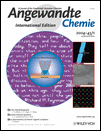Do Quantum Size Effects Control CO Adsorption on Gold Nanoparticles?†
Celine Lemire Dr.
Fritz-Haber-Institut der Max-Planck-Gesellschaft, Faradayweg 4–6, Berlin 14195, Germany, Fax (+49) 30-8413-4101
Search for more papers by this authorRandall Meyer Dr.
Fritz-Haber-Institut der Max-Planck-Gesellschaft, Faradayweg 4–6, Berlin 14195, Germany, Fax (+49) 30-8413-4101
Search for more papers by this authorShamil Shaikhutdinov Dr.
Fritz-Haber-Institut der Max-Planck-Gesellschaft, Faradayweg 4–6, Berlin 14195, Germany, Fax (+49) 30-8413-4101
Search for more papers by this authorHans-Joachim Freund Prof.
Fritz-Haber-Institut der Max-Planck-Gesellschaft, Faradayweg 4–6, Berlin 14195, Germany, Fax (+49) 30-8413-4101
Search for more papers by this authorCeline Lemire Dr.
Fritz-Haber-Institut der Max-Planck-Gesellschaft, Faradayweg 4–6, Berlin 14195, Germany, Fax (+49) 30-8413-4101
Search for more papers by this authorRandall Meyer Dr.
Fritz-Haber-Institut der Max-Planck-Gesellschaft, Faradayweg 4–6, Berlin 14195, Germany, Fax (+49) 30-8413-4101
Search for more papers by this authorShamil Shaikhutdinov Dr.
Fritz-Haber-Institut der Max-Planck-Gesellschaft, Faradayweg 4–6, Berlin 14195, Germany, Fax (+49) 30-8413-4101
Search for more papers by this authorHans-Joachim Freund Prof.
Fritz-Haber-Institut der Max-Planck-Gesellschaft, Faradayweg 4–6, Berlin 14195, Germany, Fax (+49) 30-8413-4101
Search for more papers by this authorWe acknowledge financial support from the EU Networks “Catalysis by Gold” (AURICAT) and “Reactivity of Cöean and Modified Oxide Surfaces” (Oxide Surfaces). R.M. thanks the Alexander von Humboldt Foundation for a fellowship.
Graphical Abstract
Monolayer gold islands with a thickness of one or a few monolayers on an FeO(111) substrate are found to exhibit identical CO adsorption behavior as large gold particles (see picture). This result suggests that particle thickness does not play a significant role in CO adsorption, and therefore size effects seen for the low-temperature CO oxidation reaction are not related to quantum size effects.
References
- 1G. C. Bond, Surf. Sci. 1985, 156, 966.
- 2M. Che, C. O. Bennett, Adv. Catal. 1989, 36, 55.
- 3M. Haruta, CATTECH 2002, 6, 102, and references therein.
- 4M. Haruta, Chem. Rec. 2003, 3, 75, and references therein.
- 5G. C. Bond, D. T. Thompson, Catal. Rev. Sci. Eng. 1999, 41, 319, and references therein.
- 6V. Valden, S. Pak, X. Lai, D. W. Goodman, Catal. Lett. 1998, 56, 7.
- 7M. Valden, X. Lai, D. W. Goodman, Science 1998, 281, 1647.
- 8Sh. K. Shaikhutdinov, R. Meyer, D. Lahav, M. Bäumer, T. Klüner, H.-J. Freund, Phys. Rev. Lett. 2003, 91, 076102.
- 9D. Lahav, T. Klüner, R. Meyer, Sh. K. Shaikhutdinov, H.-J. Freund, unpublished results.
- 10Sh. K. Shaikhutdinov, R. Meyer, M. Naschitzki, M. Bäumer, H.-J. Freund, Catal. Lett. 2003, 86, 211.
- 11M. Bäumer, H.-J. Freund, Prog. Surf. Sci. 1999, 61, 127.
- 12D. C. Meier, D. W. Goodman, J. Am. Chem. Soc., submitted.
- 13C. Ruggiero, P. Hollins, J. Chem. Soc. Faraday Trans. 1996, 92, 4829.
- 14J. M. Gottfried, K. J. Schmidt, S. L. M. Schroeder, K. Christmann, Surf. Sci. 2003, 536, 206.
- 15M. Mavrikakis, P. Stoltze, J. Nørskov, Catal. Lett. 2000, 64, 10.
- 16M. Mavrikakis, B. Hammer, J. K. Nørskov, Phys. Rev. Lett. 1998, 81, 2819.
- 17M. Ø. Pedersen, S. Helveg, A. Ruban, I. Stensgaard, E. Laegsgaard, J. K. Nørskov, F. Besenbacher, Surf. Sci. 1999, 426, 395.
- 18F. Cosandey, T. Madey, Surf. Rev. Lett. 2001, 8, 73.
- 19S. Ferreo, A. Piednoir, C. R. Henry, Nanoletters 2001, 1, 227.
- 20S. Giorgio, C. Chapon, C. R. Henry, G. Nihoul, J. M. Penisson, Philos. Mag. A 1991, 64, 87.
- 21S. Giorgio, C. R. Henry, B. Pauwels, G. Van Tendeloo, Mater. Sci. Eng. A 2000, 297, 197.
- 22M. Okumura, S. Nakamura, S. Tsubota, T. Nakamura, M. Azuma, M. Haruta, Catal. Lett. 1998, 51, 53.
- 23Y. Jugnet, F. J. Cadete Santos Aires, C. Deranlot, L. Piccolo, J. C. Bertolini, Surf. Sci. 2002, 521, L 639.
- 24P. Dumas, R. G. Tobin, P. L. Richards, Surf. Sci. 1986, 171, 579.
- 25D. R. Rainer, C. Xu, P. M. Holmblad, D. W. Goodman, J. Vac. Sci. Technol. A 1997, 15, 1653.
- 26C. Winkler, A. J. Carew, S. Haq, R. Raval, Langmuir 2003, 19, 717.
- 27T. Yates, T. E. Madey, Vibrational Spectroscopy of Molecules on Surfaces, Plenum, New York, 1987.
10.1007/978-1-4684-8759-6 Google Scholar
- 28C. W. Olsen, R. I. Masel, Surf. Sci. 1988, 201, 444.
- 29J. Szanyi, W. K. Kuhn, D. W. Goodman, J. Vac. Sci. Technol. A 1993, 11, 1969.
- 30J. France, P. Hollins, J. Electron Spectrosc. Relat. Phenom. 1993, 64/ 65, 251.
- 31N. Lopez, J. K. Nørskov, Surf. Sci. 2002, 515, 175.
- 32L. Giordano, G. Pacchioni, T. Bredow, J. Fernández Sanz, Surf. Sci. 2001, 471, 21.
- 33V. A. Bondzie, S. C. Parker, C. T. Campbell, J. Vac. Sci. Technol. A 1999, 17, 1717.
- 34S. R. Bahn, N. Lopez, J. K. Norskov, K. W. Jacobsen, Phys. Rev. B 2002, 66, 081 405.
- 35B. Gleich, M. Ruff, R. J. Behm, Surf. Sci. 1997, 386, 48.
- 36M. Ruff, S. Frey, B. Gleich, R. J. Behm, Appl. Phys. A 1998, 66, S 513.
- 37G. H. Vurens, M. Salmeron, G. A. Somorjai, Surf. Sci. 1988, 201, 129.
- 38G. H. Vurens, V. Maurice, M. Salmeron, G. A. Somorjai, Surf. Sci. 1992, 268, 170.
- 39M. Ritter, W. Ranke, W. Weiss, Phys. Rev. B 1998, 57, 7240.
- 40W. Weiss, W. Ranke, Prog. Surf. Sci. 2002, 70, 1.





